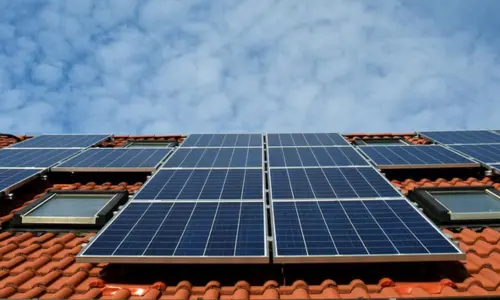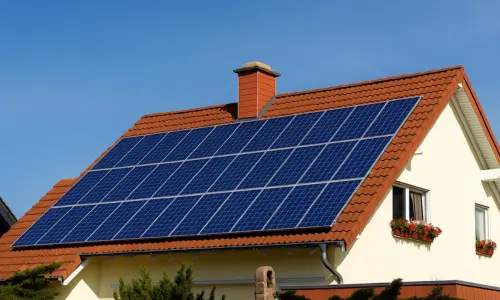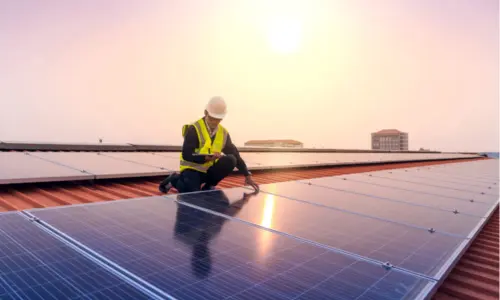Types of Rooftop Solar Systems in India

Rooftop solar systems in India are becoming one of the most popular ways to generate clean, affordable electricity directly from the sun. Installed on the rooftops of homes, offices, factories, and institutions, they help reduce electricity bills, cut reliance on the grid, and contribute to a greener future.
But not all systems are the same. Based on how they are connected and how they supply power, there are three main types of rooftop solar systems: On-Grid, Off-Grid, and Hybrid. Choosing the right one depends on your electricity usage,
location, and budget. As a trusted rooftop solar company and installer, Synergy Solar helps customers select and install the best system for their needs.

On-Grid Rooftop Solar System
An On-Grid Rooftop Solar System is directly connected to the electricity grid. It generates power during the day and supplies it to your home, office, or industry. If your panels produce more electricity than you consume, the extra power is sent back to the grid through net metering.
How It Works
Solar panels generate DC power.
The solar inverter converts DC into AC power used by appliances.
Extra power is exported to the grid (net metering).
During night or cloudy days, electricity is drawn from the grid.
Advantages
Easy to install and maintain with long lifespan
Net metering reduces monthly electricity bills
Lower upfront cost (no batteries required)
Limitations
Does not work during power cuts (safety shutdown)
Requires a stable grid connection
Best For: Homes, offices, and industries in cities with reliable grid supply and high power bills.

Off-Grid Rooftop Solar System
An Off-Grid Rooftop Solar System works independently without relying on the grid. It uses solar batteries to store energy for use during the night or power cuts.
How It Works
Solar panels generate DC electricity.
A solar inverter converts DC into AC power.
Surplus power is stored in solar batteries.
During night or outages, stored energy is used.
Advantages
Works in areas where grid is not available
Provides full power backup during outages
Energy independence from electricity board
Limitations
Higher cost due to batteries
Batteries need maintenance and replacement every 5–7 years
Not economical in cities with cheap, stable grid supply
Best For: Remote villages, agricultural farms, telecom towers, or homes with frequent power cuts.

Hybrid Rooftop Solar System
A Hybrid Rooftop Solar System combines the benefits of On-Grid and Off-Grid systems. It connects to the grid but also has batteries for storage, ensuring both savings and backup.
How It Works
Solar panels generate electricity.
Extra energy is stored in batteries and can also be sent to the grid.
During outages, the system automatically switches to battery backup.
Power is first used to run appliances.
Advantages
Uninterrupted power supply (savings + backup)
Eligible for net metering and subsidy (grid part)
Reliable for homes, hospitals, industries, and offices
Limitations
Higher initial investment (inverter + batteries)
Requires extra space for battery bank
Best For: Homes, hospitals, businesses, and industries where power backup is critical.
Factors to Consider Before Choosing a Rooftop Solar System
Installing a rooftop solar system is a long-term investment, so it’s important to choose the right type for your home, office, or industry. Here are the key factors to keep in mind:
Location & Grid Availability
- In cities with reliable power supply, On-Grid is the most practical choice.
- In rural or remote areas with frequent outages, Off-Grid or Hybrid systems are more suitable.
Budget
- On-Grid systems are the most affordable since they don’t need batteries.
- Hybrid systems cost more but provide both savings and backup.
- Off-Grid systems are the most expensive because of batteries and storage.
Energy Needs
- If your goal is only to reduce electricity bills, an On-Grid Rooftop Solar System is the best option.
- If you also need backup during power cuts, go for a Hybrid or Off-Grid system.
Long-Term ROI
- On-Grid and Hybrid systems usually pay back their cost in 3–5 years.
- Off-Grid systems take longer due to battery costs but ensure energy independence.
Government Subsidy
- Subsidy is available only for On-Grid and Hybrid (grid-tied) residential systems under MNRE guidelines.
- Off-Grid systems are not eligible for subsidy.
Roof Space
- Solar panels need around 100 sq. ft. per kW of shadow-free space.
- Check if your roof can accommodate the required system size.
As a leading rooftop solar supplier and installer, Synergy Solar guides you in selecting the right rooftop solar system for your home, business, or commercial property. From system design and subsidy application to installation and maintenance, we provide complete end-to-end support.
Solar Farm Business Opportunities for Farmers
Parameter | On-Grid | Off-Grid | Hybrid |
| Grid dependency | Required | Not connected | Optional (works with/without) |
| Battery | No | Yes (mandatory) | Yes (recommended) |
| Round-trip losses | Minimal | Battery 10–25% | Battery 8–15% (LiFePO₄) |
| Capex per kW | Low | High (battery heavy) | Medium-High |
| Subsidy (residential) | Yes | No | Yes (grid-tied portion) |
| Anti-islanding | Yes | N/A | Yes |
| Zero-export capability | Via external limiter | N/A | Native/CT or external limiter |
| Best use case | Savings w/ stable grid | No grid / critical backup | Savings + backup + policy flexibility |
Why Choose Synergy Solar?
Expertise in all types of rooftop solar systems (on-grid, off-grid, hybrid)
End-to-end services – site survey, design, subsidy support, installation, and maintenance
Transparent pricing and clear ROI calculations
MNRE-approved components and structures
1000+ successful installations across homes, offices, and industries
Frequently Asked Questions (FAQs) on Rooftop Solar in India
What is a rooftop solar system and how does it work?
A rooftop solar system uses solar panels installed on your roof to generate electricity from sunlight. The power is converted through an inverter for household or business use. Extra power can be exported to the grid (on-grid) or stored in batteries (off-grid/hybrid).
Which rooftop solar system is best for my home?
• If your goal is to save on bills → On-Grid is best.
• If you face frequent power cuts → Hybrid or Off-Grid is better.
A trusted rooftop solar installer like Synergy Solar can guide you after a site survey.
What government subsidy is available for rooftop solar?
Under MNRE, residential users can get 40% subsidy for systems up to 3 kW and 20% for 4–10 kW. Subsidies apply only to on-grid and hybrid systems for homes, not for commercial/industrial projects.
How much roof space is required for rooftop solar panels?
On average, 1 kW of rooftop solar requires about 100 sq. ft. of shadow-free roof area. A 5 kW system would need around 500 sq. ft.
How much does rooftop solar cost in India in 2025?
The average rooftop solar cost in India is ₹45,000–₹60,000 per kW for residential systems after subsidy. Commercial and industrial systems cost ₹35,000–₹50,000 per kW due to larger scale.
What is the difference between On-Grid, Off-Grid, and Hybrid rooftop solar?
• On-Grid: Connected to grid, cheapest, subsidy available, no backup.
• Off-Grid: Works without grid, uses batteries, higher cost.
• Hybrid: Grid + battery, backup during outages, higher investment but reliable.
How do I apply for rooftop solar subsidy in India?
You can apply through the National Rooftop Solar Portal or your state DISCOM. At Synergy Solar, we assist customers with registration, documentation, and approvals.
Can rooftop solar work during power cuts?
• On-Grid systems shut down during outages.
• Hybrid and Off-Grid systems continue supplying power using batteries.
What is the payback period or ROI for rooftop solar?
A rooftop solar system typically has a payback period of 3–5 years. After this, electricity is almost free for the remaining 20+ years, giving an ROI of 18–25% annually.
How long do rooftop solar panels last?
Most solar panels last 25–30 years with minimal maintenance. Inverters usually last 8–10 years, while batteries (in hybrid/off-grid systems) need replacement every 5–7 years.
Can we help you?
